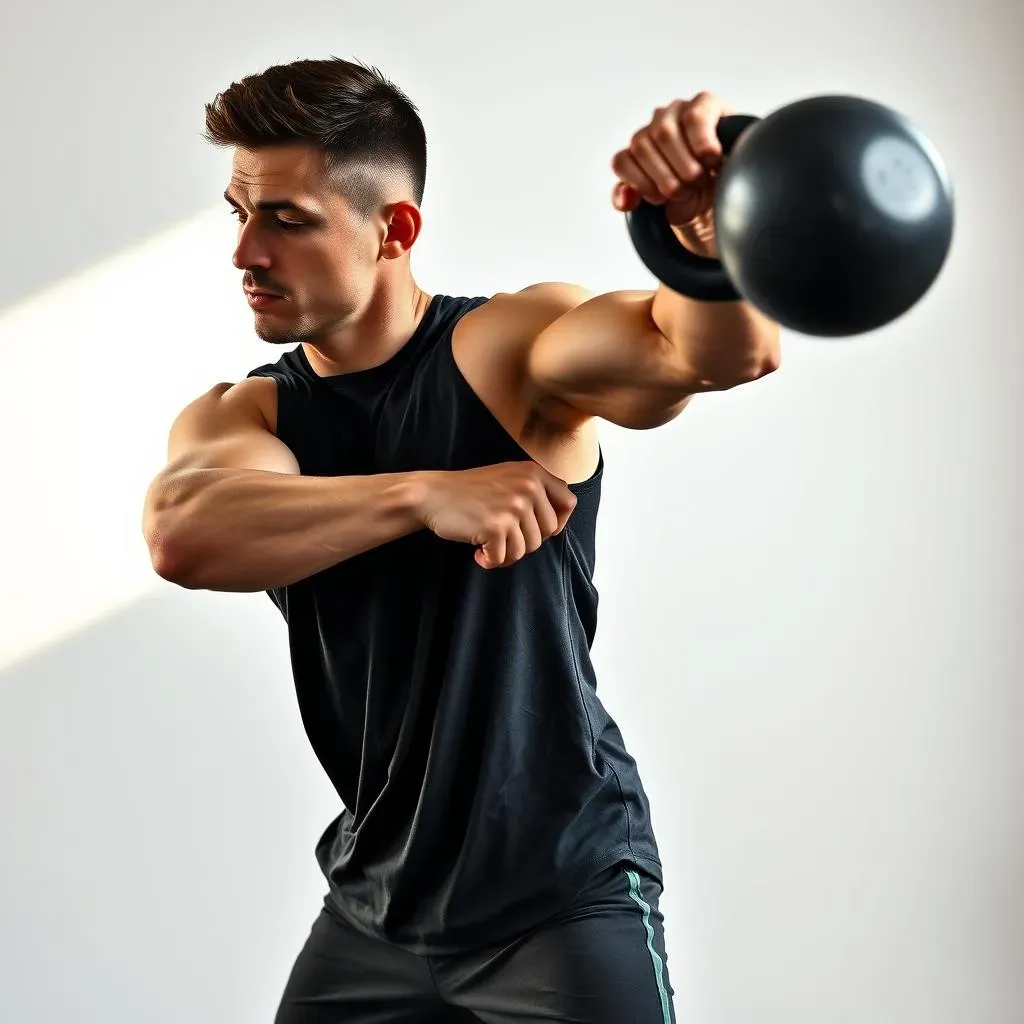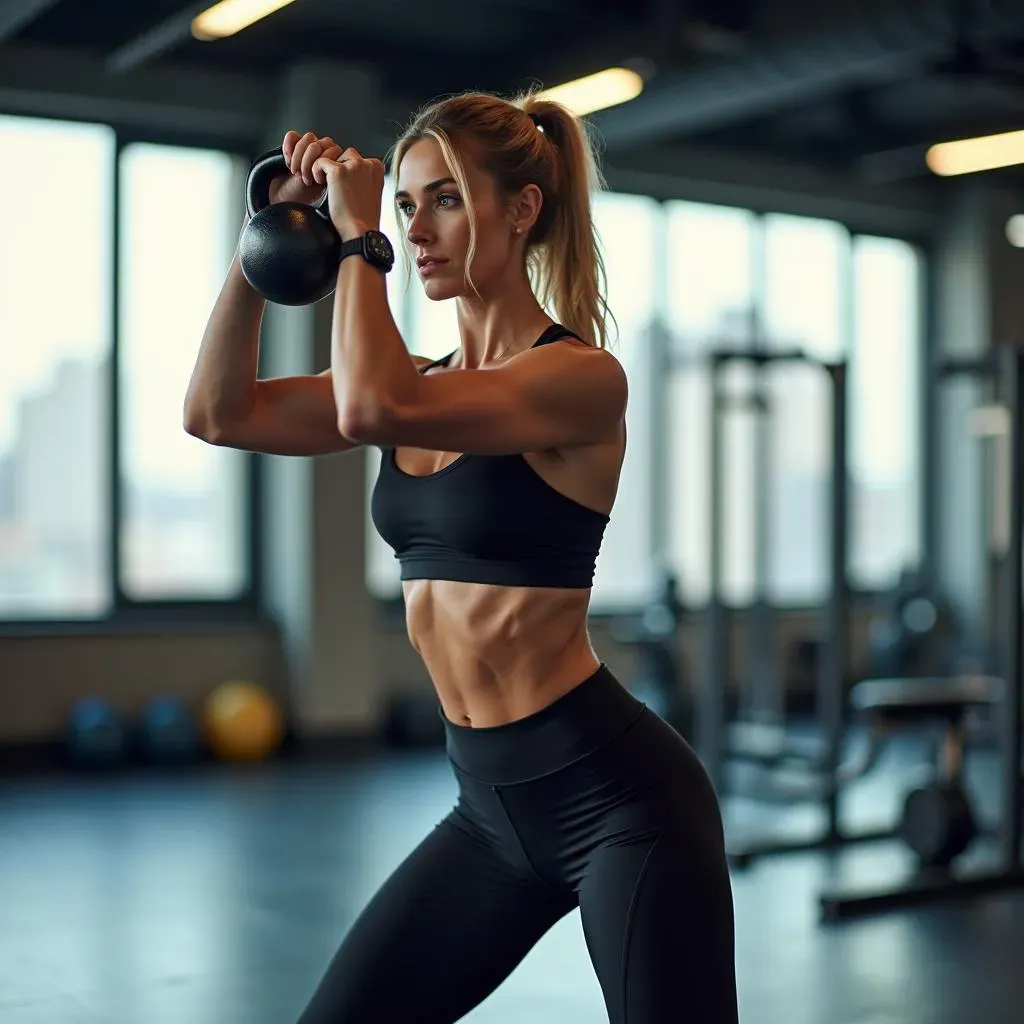Table of Contents
Ready to blast fat, build muscle, and have a seriously fun workout, all without needing a gym membership? Then get ready to discover the power of the kettlebell HIIT workout for beginners! This article is your complete guide to crushing your fitness goals with this incredibly effective training method. We'll start by ensuring you're completely safe and prepared, covering essential warm-up techniques and proper kettlebell handling. Next, we'll dive into a selection of beginner-friendly kettlebell HIIT exercises, each explained clearly with helpful visuals (coming soon!). You'll learn how to perform each exercise correctly, avoiding common mistakes that could hinder your progress or even lead to injury. Finally, we’ll empower you to create your own personalized kettlebell HIIT workout routine tailored to your fitness level and goals. By the end, you’ll not only understand the "how" but also the "why" behind this fantastic workout, and you'll be ready to unleash your inner fitness warrior. So grab your kettlebell (or find out which one is right for you!), and let's get started on your journey to a fitter, stronger you with this kettlebell HIIT workout beginner guide!
Beginner Kettlebell HIIT: Getting Started Safely

Beginner Kettlebell HIIT: Getting Started Safely
Beginner Kettlebell HIIT: Getting Started Safely
So, you're diving into the world of kettlebell HIIT workouts? Awesome! But before you swing that kettlebell like a pro, let's make sure we're starting safely. Think of it like this: you wouldn't jump into a swimming pool without knowing how to swim, right? It's the same with kettlebell training. Proper form is key to avoiding injuries and getting the most out of your workout. First things first, choose a kettlebell that's the right weight for you. Start light! It’s better to start with a lighter weight and gradually increase it as you get stronger. Remember, you're building a foundation here, not trying to break any lifting records on day one. A good rule of thumb is to choose a weight that allows you to maintain good form throughout the entire set. Don’t compromise your form for heavier weight, it is a bad idea.
Before you even think about swinging that kettlebell, warm up those muscles! A proper warm-up helps prepare your body for the workout ahead, reducing the risk of injury and improving performance. Think of a simple 5-10 minute warm-up routine including some light cardio like jumping jacks or jogging on the spot, dynamic stretches like arm circles and leg swings, and some activation exercises, like this beginner kettlebell workout routine. This will prepare your muscles for the more intense workout that is to come. Once you've chosen your kettlebell and warmed up, it’s time to learn the basic movements. There are tons of resources online, and even better, check out some videos to get a visual understanding before you start. Mastering the fundamental movements will set you up for success in your HIIT routine. Remember that a solid foundation in proper form will help prevent injuries and maximize your results. Think of it as investing in your long-term fitness journey. A little extra time spent on preparation is a worthwhile investment.
Warm-up Activity | Duration (minutes) | Description |
|---|---|---|
Jumping Jacks | 2 | Jump with legs spread wide, arms overhead. |
High Knees | 2 | Bring knees high towards chest while jogging in place. |
Arm Circles | 1 | Small and large circles forward and backward. |
Dynamic Stretching (Leg Swings, Torso Twists) | 3 | Controlled movements through a full range of motion. |
Light Cardio (Jogging in place) | 2 | Increase heart rate and blood flow. |
Now, let's talk about posture. Good posture is crucial for injury prevention. Stand tall with your feet shoulder-width apart, engaging your core muscles. You want to feel stable and balanced. Imagine a string pulling you up from the crown of your head; this will help you maintain a straight spine and avoid hunching over. This is important for all kettlebell exercises, not just HIIT. You'll feel more powerful, and you'll be protecting yourself from injury.
Another important aspect of safety is listening to your body. If something feels wrong, stop. Don't push through pain. Rest if you need to. It's better to take a break than to risk injuring yourself. Remember, progress is a marathon, not a sprint. Consistency and proper form are more important than trying to do too much too soon. This will help you avoid burnout and build a sustainable fitness routine. Check out this beginner kettlebell workout for women for a great starting point. It's designed to be gentle and effective.
- Listen to your body – if something hurts, stop!
- Prioritize proper form over speed or weight.
- Rest when needed to avoid injury and burnout.
- Start slowly and gradually increase intensity.
- Don't be afraid to ask for help or guidance.
Effective Kettlebell HIIT Exercises for Beginners

Effective Kettlebell HIIT Exercises for Beginners
Alright, let's get into some seriously effective kettlebell HIIT exercises perfect for beginners. We're going to focus on movements that are both challenging and safe, building a solid foundation for your fitness journey. Remember, proper form is paramount—it’s better to do fewer reps with perfect form than many with sloppy form. We'll start with the kettlebell swing. It’s a foundational move that works your entire body, especially your posterior chain (glutes, hamstrings, and lower back). Think of it as a powerful hip hinge, using your legs and glutes to generate momentum, not just your back. This is a fantastic exercise to improve your cardiovascular fitness and build strength simultaneously. A good starting point is to aim for 10-15 swings per round, building up as you get stronger. Check out this beginner kettlebell workout for more guidance.
Next up is the goblet squat. Hold the kettlebell close to your chest, like you're holding a big, heavy goblet. Squat down as if sitting in a chair, keeping your back straight and your chest up. This exercise is amazing for building leg strength and improving your balance. Aim for 10-12 reps per round. This is a great exercise to build leg strength and improve lower body stability. Remember to keep your core engaged throughout the movement to help maintain a stable and upright posture. For a more challenging variation, you can try the sumo squat, which involves a wider stance. You can also try this beginner kettlebell workout for women which includes goblet squats.
- Kettlebell Swings: 10-15 reps
- Goblet Squats: 10-12 reps
Now let's add some upper body work with the kettlebell press. Start with the kettlebell at shoulder height, then press it straight overhead. It’s all about controlled movement and maintaining a stable core. This exercise builds shoulder and arm strength while also improving your overall upper body coordination. Try 8-10 reps per arm. Remember to keep your core engaged and your back straight to prevent injury and maximize the effectiveness of the exercise. For variations, you can try alternating arms or doing both arms simultaneously. This is a great exercise for improving your upper body strength and overall fitness.
Finally, let's incorporate a bit of a cardio burst with the kettlebell rows. Hinge at the hips, keeping your back straight, and pull the kettlebell towards your chest. This is a great exercise for building back strength and improving your posture. This move works your back muscles effectively and helps improve your posture. Aim for 10-12 reps per arm. Remember to maintain a flat back and avoid rounding your spine. This will ensure you are targeting the correct muscles and are minimizing the risk of injury. We can explore more advanced rowing techniques as you progress. Check out this guide on beginner kettlebell arm workouts for more details. These are some of the best exercises for beginners.
Exercise | Reps | Sets | Rest |
|---|---|---|---|
Kettlebell Swing | 15 | 3 | 30 seconds |
Goblet Squat | 12 | 3 | 30 seconds |
Kettlebell Press | 10 (each arm) | 3 | 30 seconds |
Kettlebell Row | 12 (each arm) | 3 | 30 seconds |
Designing Your Own Kettlebell HIIT Workout for Beginners

Designing Your Own Kettlebell HIIT Workout for Beginners
Choosing Your Exercises
Now that you've mastered some basic kettlebell moves, it's time to get creative and design your own killer HIIT workout! The beauty of HIIT is its flexibility. You can tailor it to your fitness level, available time, and personal preferences. Think of it like building with LEGOs – you have a bunch of awesome pieces (exercises), and you get to decide how to put them together to create something amazing! Start by selecting 3-4 exercises from the ones we've covered – kettlebell swings, goblet squats, presses, and rows – or add others you're comfortable with. Remember, variety is the spice of life (and fitness!), so don't be afraid to mix things up. Consider including exercises that target different muscle groups to ensure a well-rounded workout.
For example, you could combine kettlebell swings for a full-body blast with goblet squats to target your legs and core, then finish with kettlebell rows to work your back. This approach ensures a balanced workout that addresses various muscle groups. You can also create a workout plan based on your personal preferences and fitness goals. Remember to begin with a plan that is both challenging and achievable. If you're feeling adventurous, explore some more advanced exercises, but only after you've mastered the basics. Remember to always prioritize proper form over the number of repetitions.
- Choose 3-4 exercises that target different muscle groups.
- Consider your fitness level and available time.
- Don't be afraid to experiment and find what works best for you.
Structuring Your HIIT Workout
Now, let's structure your workout. A typical HIIT workout involves short bursts of intense exercise followed by brief recovery periods. For beginners, a good starting point is a 30-second work interval followed by a 30-second rest interval. You can adjust these intervals as you get fitter. Remember, consistency is key. Start with a shorter workout, maybe 15-20 minutes, and gradually increase the duration and intensity as you feel more comfortable. You could start with two rounds of each exercise, gradually working your way up to three or four. Listen to your body; if you're feeling overwhelmed, take a break. Remember, progress is a marathon, not a sprint. Check out this 15-minute kettlebell workout for a sample routine.
You can structure your workout in various ways. One effective approach is to perform each exercise for the specified duration, then take a short rest before moving on to the next exercise. After completing all the exercises, you can take a longer rest before repeating the circuit. Another option is to perform a set number of repetitions for each exercise, followed by a short rest, and then repeat the set. The key is to find a structure that works for you and keeps you motivated. Remember, the goal is to challenge yourself while maintaining proper form and listening to your body's signals. For more detailed guidance, consider checking out this comprehensive guide on kettlebells.
Round | Exercise 1 | Exercise 2 | Exercise 3 |
|---|---|---|---|
1 | Kettlebell Swings (30 sec) | Goblet Squats (30 sec) | Kettlebell Rows (30 sec) |
2 | Kettlebell Swings (30 sec) | Goblet Squats (30 sec) | Kettlebell Rows (30 sec) |
Tracking Your Progress and Making Adjustments
Once you have a workout routine, it's crucial to track your progress and make adjustments as needed. Keep a workout log to note the exercises you perform, the number of repetitions or sets, and how you felt during the workout. This information will help you monitor your improvement and identify areas where you need to make adjustments. For example, you might notice that you're able to complete more repetitions of a particular exercise over time. This indicates that you are getting stronger and can increase the intensity or duration of the exercise. Alternatively, if you are struggling to maintain proper form during an exercise, you may need to reduce the weight or the number of repetitions. Remember, consistency is key, but it's equally important to listen to your body and adjust your plan based on your needs.
Don't be afraid to experiment with different exercise combinations and workout structures to find what best suits your needs. The key is to create a challenging yet sustainable routine that you can stick with over time. Remember that consistency is crucial for achieving your fitness goals. It's better to have a simple workout that you can do regularly than a complicated workout that you abandon after a few days. This approach ensures that you will continue to see results and maintain your motivation. Consider using a fitness tracker or app to help monitor your progress and keep you motivated. For additional support and motivation, check out our beginner kettlebell program: beginner kettlebell program.
- Keep a workout log to track your progress.
- Adjust your workout based on your fitness level and how you feel.
- Don't be afraid to experiment and find what works best for you.
- Prioritize consistency over intensity.